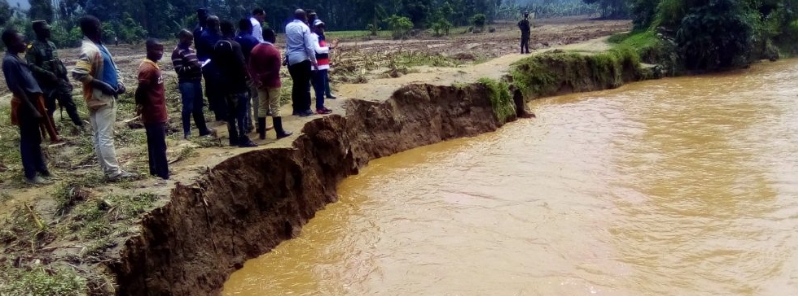Heavy rains, floods and landslides claim at least 60 lives in Rwanda, more than 1 000 homes damaged

Heavy rains, floods, and landslides affecting Rwanda since January 2020 have killed more than 60 people and damaged more than 1 000 homes, the Ministry of Emergency Management (MINEMA) reported. At least 10 lives have been lost since the beginning of March. Over 11 000 residents in the capital Kigali are set to be relocated from high-risk zones as the country's meteorological agency forecasts destructive rains to continue until May.
At a news conference Monday, March 9, city authorities stated that the relocation will cost roughly 84 000 dollars or 80 million francs, which will be mainly allocated for two months of rent for the evacuees.
According to mayor Pudence Rubingisa, a city-wide assessment is underway to determine vulnerable households and displace them to safer areas.
Moreover, part of the contingency plan is the demolition of unstable houses that are more prone to danger, specifically homes built in wetlands, near drainage, and close to water retention places.
The affected population will include parts of the Kimisagara sector, Kangondo 1 and 2 in Nyarutarama, Mulindi, Rwampara, as well as parts of Rugando known as Kumyembe and Nyabisindu in Kimironko.
Minister of Local Government Anastase Shyaka said the plan aims to protect the lives of the citizens and prevent more property loss. Meanwhile, authorities said the construction of 392 houses in Kangondo village will be done by June, which will house around 700 displaced families.
The Rwanda Meteorological Agency predicted that above-normal, heavy rains will continue until May, which are expected to cause further hazards, with Kigali and the southwest portion bordering the Nyungwe forest to face the worst.
"Consequences that we are facing are likely to persist due to the rainfall," agency director-general Aimable Gahigi said.
Umujyi wa #Kigali urashishikariza abaturage bagituye ahantu hashyira ubuzima bwabo mu kaga nko munsi y'imikingo, hafi ya za ruhurura, hafi y'imbibi z'ibishanga n'ahandi kwimuka vuba kuko iteganyagihe rya @MeteoRwanda rigaragaza ko hitezwe imvura nyinshi muri ibi bihe #SaveLives pic.twitter.com/4xxCRkYDLw
— City of Kigali (@CityofKigali) March 11, 2020
@RubavuDistrict: Kubera imvura imaze iminsi igwa, umugezi wa #Sebeya wongeye kuzura uteza ibiza mu baturage ndetse wangije n'imirima. @RadioRubavu iri mu murenge wa #Kanama gukurikirana inkuru ku bibasiwe n'icyo kiza.@rbarwanda #RBANews #Rwanda @RwandaEmergency @RwandaLocalGov pic.twitter.com/TACJTKTfKf
— Radio Rubavu (RC Rubavu) (@RadioRubavu) March 6, 2020
Director General of Rwanda Water Resources Board @Ngaprime, Mayor of Rubavu District Gilbert Habyarimana and Security Organs @RwandaMoD & @Rwandapolice have made a field visit in the area affected by recent #Sebeya floods. pic.twitter.com/Hy7RN3ENP4
— Rwanda Water Resources Board (@RwandaWater) March 7, 2020
Mu gihe hagiye gukomeza ibikorwa byo gufasha abaturage kwimuka bava ahashobora kubateza akaga muri ibi bihe by'imvura idasanzwe;
Turasaba Abanyarwanda gufasha Leta bakimuka bakava mu bishanga n'amanegeka vuba mu kwirinda ibiza byabatwarira ubuzima. pic.twitter.com/SSBxW1WZXJ— Ministry of Local Government | Rwanda (@RwandaLocalGov) March 10, 2020
#Rwanda as a clear case study, the impact of climate change has been tragic.
This week, 5 people lost their lives due to heavy rains & floods, 13 people injured & 42 houses destroyed while 51 people lost their lives Since the beginning of this year.#RwOT pic.twitter.com/Lcvq9qm3kj— RadioTv10 Rwanda (@Radiotv10rwanda) March 5, 2020
Heavy downpour since January this year has had widespread impacts in the country. Post-harvest activities in rural areas were disrupted, resulting in woes in food prices.
Furthermore, drinking water infrastructure was affected, causing water supply shortages, particularly in some areas in Kigali. Transport and construction activities were also hampered.
Up to 1 000 residential properties were damaged, as well as 700 ha (1 728 acres) of field crops, roads, and bridges.
The severe weather has also caused more than 60 fatalities due to floods and landslides, while over 90 people sustained injuries, according to MINEMA.
At least 10 deaths were reported since the beginning of March, including two in Ruhango, and one each in Gasabo and Rulindo. On March 5, five more fatalities were confirmed after heavy rain caused a river to burst, flooding a cave in Nyamagabe. MINEMA added that most of the casualties were caused by flooding and lightning.
Featured image credit: Rwanda Water Resources Board

Commenting rules and guidelines
We value the thoughts and opinions of our readers and welcome healthy discussions on our website. In order to maintain a respectful and positive community, we ask that all commenters follow these rules:
We reserve the right to remove any comments that violate these rules. By commenting on our website, you agree to abide by these guidelines. Thank you for helping to create a positive and welcoming environment for all.